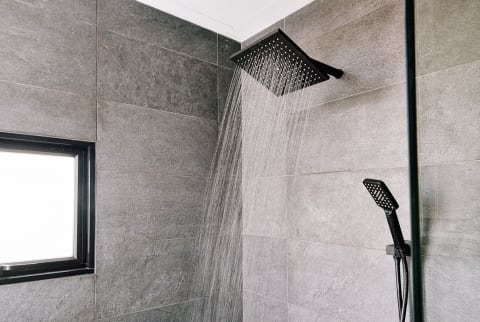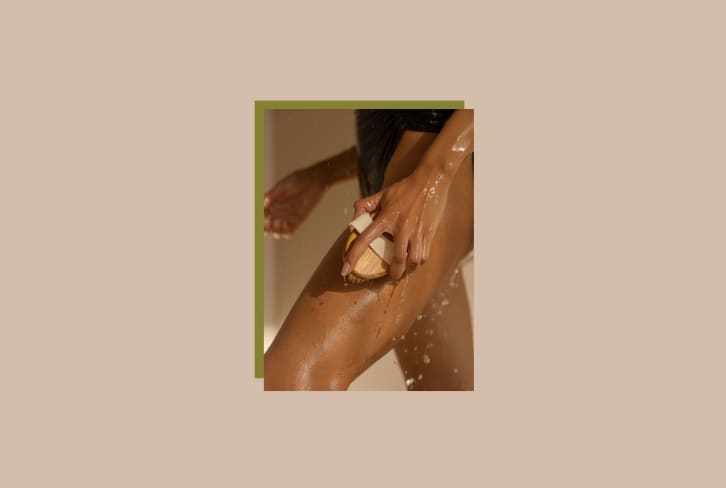Advertisement
The Best Way To Keep Mold Out Of Your Bathroom — With Or Without An Exhaust Fan


With all the shower running, toilet flushing, and faucet turning happening in our bathrooms, the air in there is constantly being flooded with water particles. And unfortunately, more moisture means more opportunities for mold to sneak in and start growing in our safe havens.
All it takes is 24 to 48 hours for a mold spore to put down roots and spread, releasing more spores into your air in the process. Some species also release microscopic particles called mycotoxins when they feel threatened, which is a double whammy for the indoor air quality and your health. That's why it's important to maintain good airflow in the bathroom at all times. This requires actively replacing its moisture-filled air with drier air from outside of the water-prone room. Less moisture means fewer opportunities for mold to start growing and spreading.
The U.S. Environmental Protection Agency recommends keeping indoor humidity levels between 30 and 50%1 to prevent mold, so keep that in mind for your target level. How you go about achieving this percentage will depend on whether your bathroom has an exhaust fan and/or window.
Here are some top tips for maintaining good airflow in your bathroom after bathing, no matter your setup.
Bathrooms with exhaust fans.
If you have an exhaust fan, turn it as you pop in for your bath or shower. The fan will help pull moisture-rich water out of the bathroom and should pump it outside of your home. Pro tip: A good rule of thumb is to check to make sure that the exhaust fan duct doesn't vent to a location like the inside of an attic. When that warm, moisture-rich air meets a cold surface, it can create condensation and potentially lead to—you guessed it—mold growth.
Keep the fan on for at least 30 minutes after you're finished bathing to make sure as much moisture as possible is removed. All that water-filled air needs to be replaced, so the next step is to crack a door. This will allow drier air from outside of the room to come in and replace the moist air that was lost to the vent, helping maintain lower humidity and preventing condensation. If you live in an apartment with roommates or don't feel comfortable cracking the door, an open window will do the trick as well.
Bathrooms with windows but no exhaust fan.
For these bathroom setups, the best way to create airflow is to open the window as soon as you begin your bath or shower. This will start releasing that moisture-filled air to an area outside of the bathroom. After that, the next move will be to crack that bathroom door. Again, this will create airflow throughout the room using drier air from elsewhere in your home.
Bathrooms with no windows and no exhaust fan.
These are trickier but not impossible to tackle. Your best bet is to invest in a dehumidifier and turn it on every time you start your bathroom procedure. This machine will filter out all of that water from the air that's being added from the shower, toilet, or sink faucet.
Cracking the door as much as possible will also help to better promote bathroom airflow and continue to circulate drier air throughout the room.
Dehumidifiers aren't just great for bathrooms with no windows or exhaust fans. If you're following the steps above but the humidity remains high, consider investing in one of these machines and using it to remove more of that excess moisture.
The takeaway.
No one wants to hang out with mold while they're getting ready for work or relaxing after a hard day. Adding little preventive steps like these to your bathroom routine is an excellent way to help keep your sanctuary clean and healthy for you and your family.
Watch Next
Enjoy some of our favorite clips from classes
Enjoy some of our favorite clips from classes
What Is Meditation?
Mindfulness/Spirituality | Light Watkins
Box Breathing
Mindfulness/Spirituality | Gwen Dittmar
What Breathwork Can Address
Mindfulness/Spirituality | Gwen Dittmar
The 8 Limbs of Yoga - What is Asana?
Yoga | Caley Alyssa
Two Standing Postures to Open Up Tight Hips
Yoga | Caley Alyssa
How Plants Can Optimize Athletic Performance
Nutrition | Rich Roll
What to Eat Before a Workout
Nutrition | Rich Roll
How Ayurveda Helps Us Navigate Modern Life
Nutrition | Sahara Rose
Messages About Love & Relationships
Love & Relationships | Esther Perel
Love Languages
Love & Relationships | Esther Perel

















